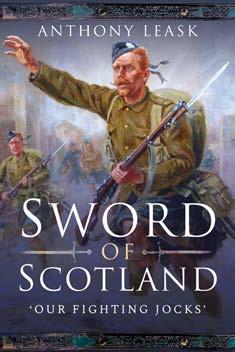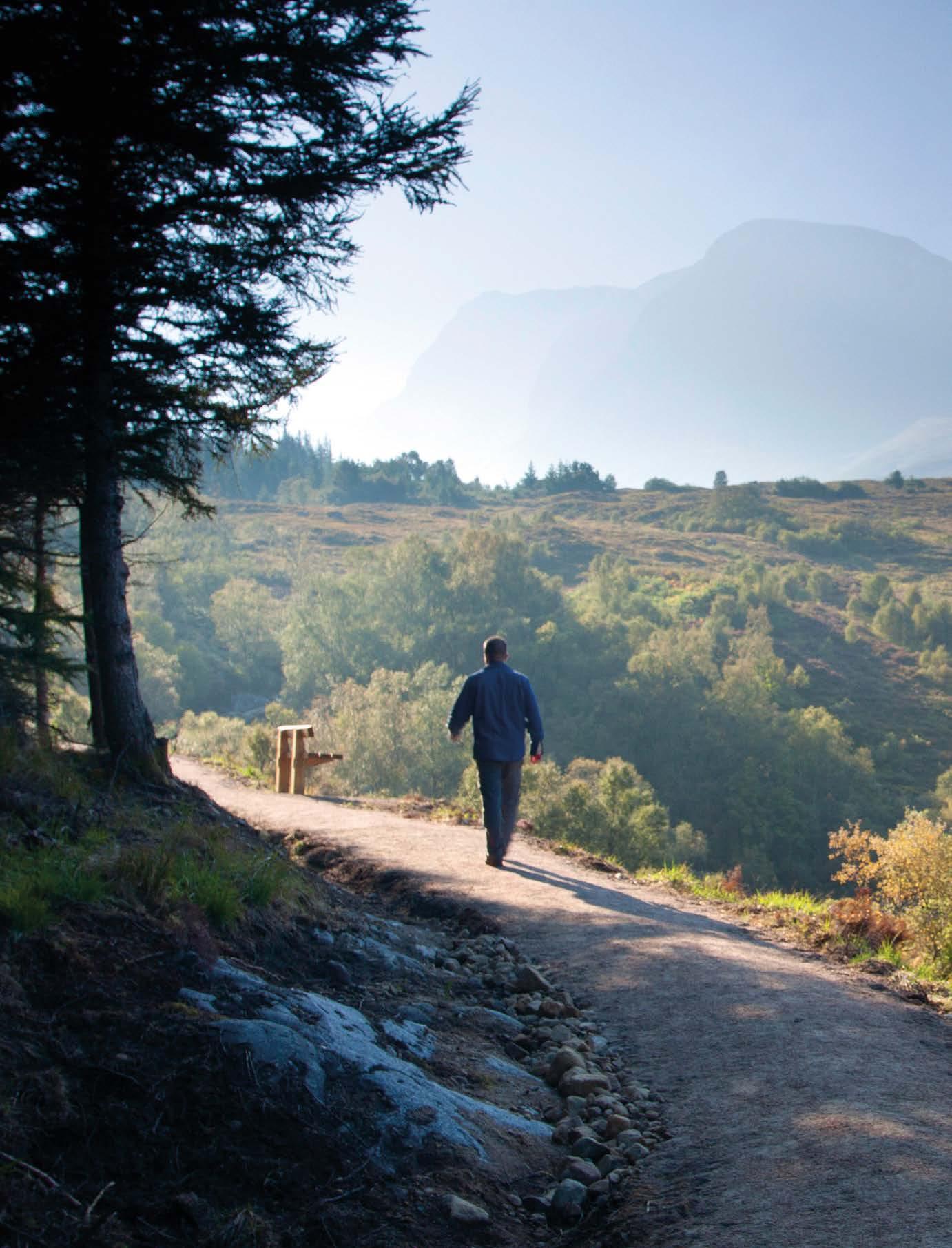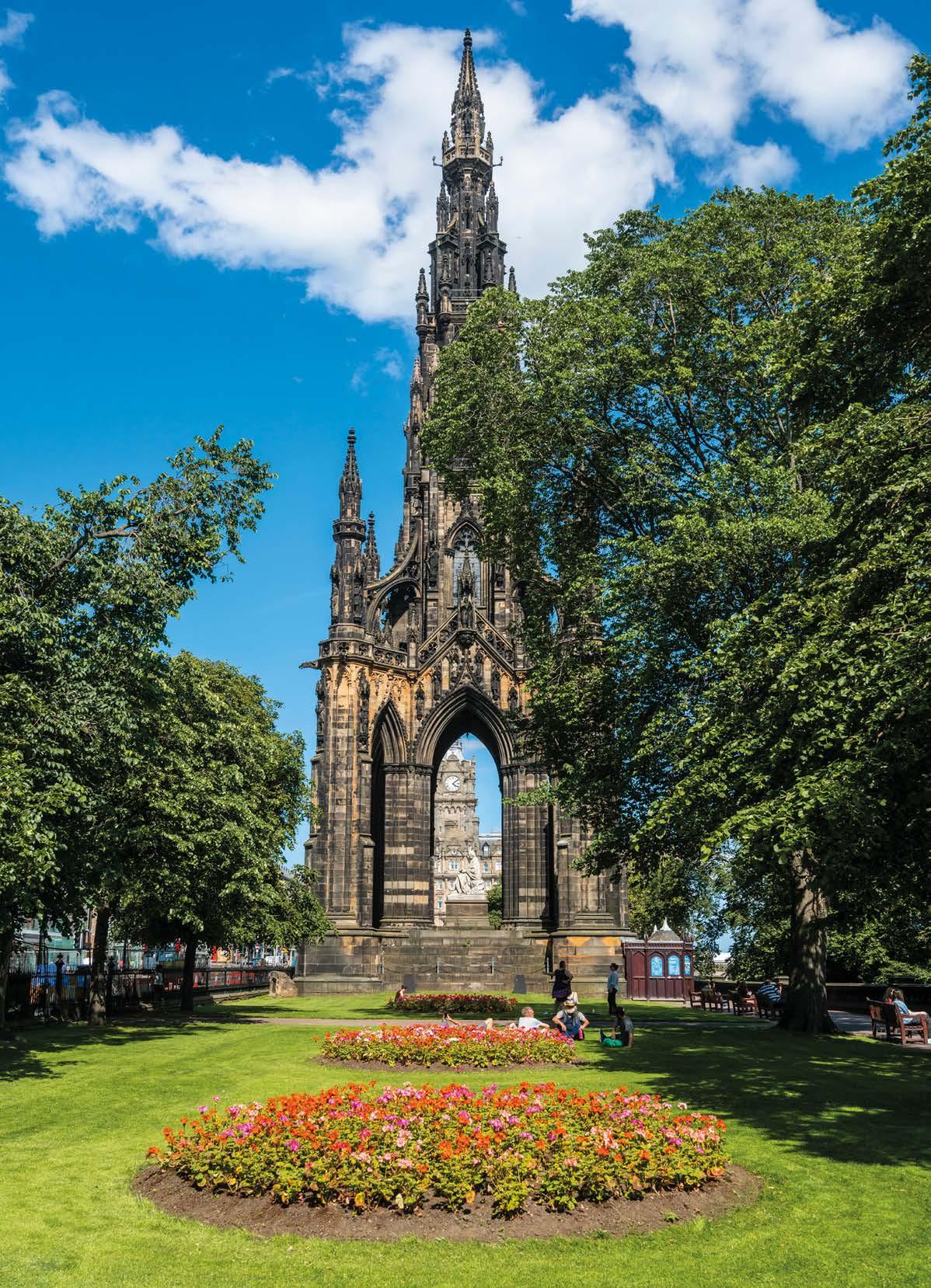
9 minute read
Great Scott
LEFT: The Scott Monument is an iconic landmark in Edinburgh RIGHT: Portrait of Sir Walter Scott by Henry Raeburn, c.1820s
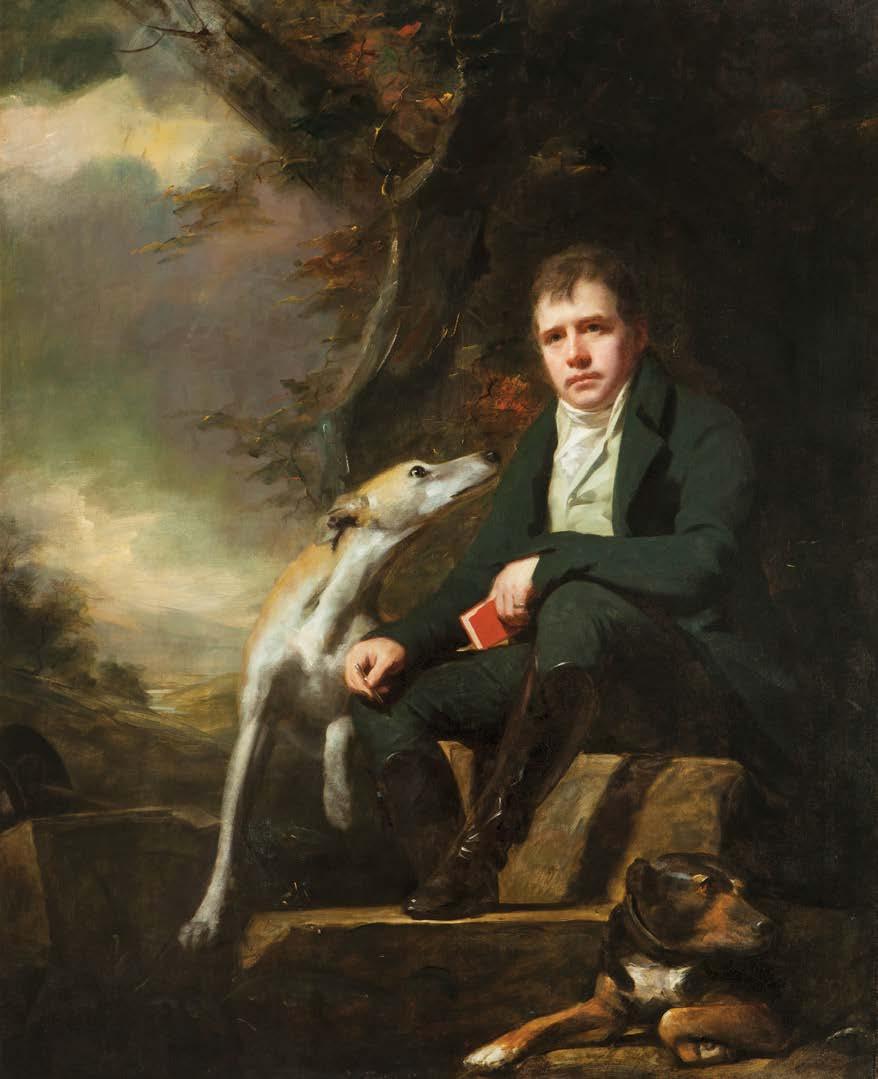
Words by FIONA LAING
Scotland’s early tourist industry was enriched by Sir Walter Scott, the author and poet who was born 250 years ago in Edinburgh


Sir Walter Scott, the writer, politician and man of the law, left his mark on Scotland: a bookcase full of classic novels and poems, a fascinating stately home in the Borders, a clutch of impressive monuments in his honour and a railway station named after his work. As Scotland emerges from the pandemic, eager to welcome visitors back, it is interesting to recall how Scott – born 250 years ago in 1771 – sowed the seeds of today’s tourism industry.
“Initially through his poetry Scott gives very detailed and evocative descriptions of the Scottish landscape,” says Professor Ali Lumsden, co-director of the Walter Scott Research Centre at Aberdeen University.
“He sets wonderful stories against those landscapes, which capture people’s imagination and make them want to go and see things for themselves.”
She adds that tourists were already visiting Scotland in Scott’s day thanks to accounts of the 1773 Highland tours of Samuel Johnson and James Boswell and James Macpherson’s Ossian poems, published in 1761.
“What Scott does is consolidate that, so the number of tourists explodes. Feeding into that is the rise of printing and reading and Scott is fortunate that his books are sold in unprecedented numbers. The fact that he told good stories made him popular.”
Scott’s works were also quickly adapted into operas and dramas, so that by the 1820s people were encountering his vision of Scotland in several ways.
“There are other things happening. The Napoleonic Wars close off Europe as a tourist destination so people can’t go on the Grand Tour and Scotland becomes the destination of choice,” adds Lumsden.
Nowhere is the legacy of Scott more obvious than at Loch Katrine in the Trossachs. Visitors today flock to the picturesque loch that Scott used as the setting for his third narrative poem, The Lady of the Lake.
Published in 1810, it was an immediate hit and visitors were soon heading to see where he wrote lines such as these:
The western waves of ebbing day
Rolled o’er the glen their level way;
Each purple peak, each flinty spire,
Was bathed in floods of living fire. The publication seven years later of Rob Roy, the third of his hugely popular Waverley novels, just added TOP LEFT: to the area’s appeal. The Entrance Hall “We justly claim Loch Katrine is at Abbotsford LEFT: SS Sir Walter Scott sails towards the birthplace of tourism in Scotland largely because of Sir Walter Scott,” Stronachlachar says James Fraser, chairman of the
RIGHT: Abbotsford, the home of Sir Walter Scott in the Borders
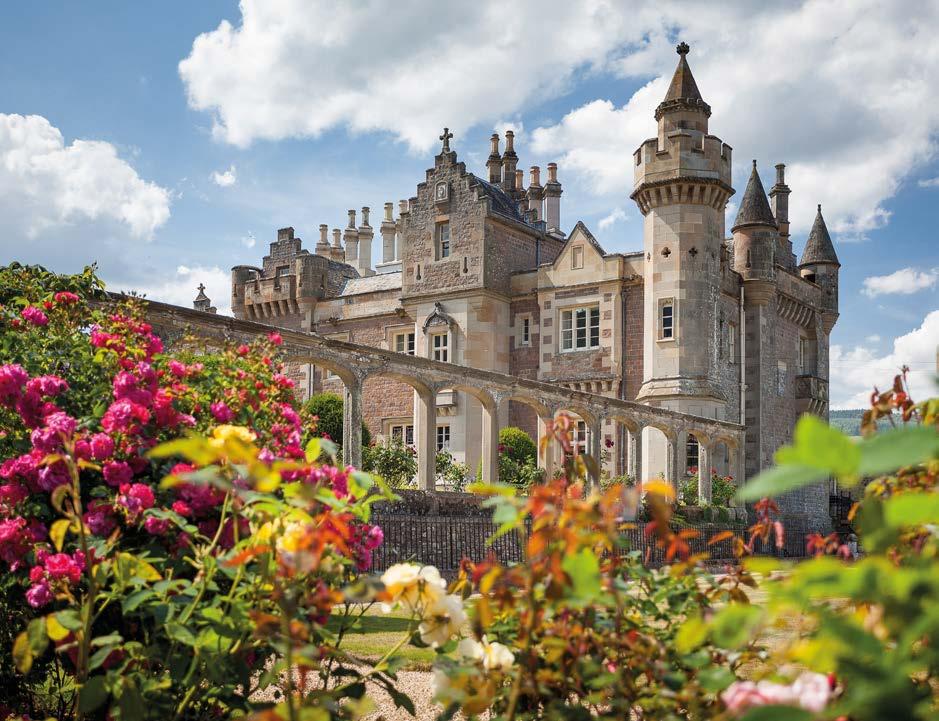
Friends of Loch Lomond and the Trossachs. “He was Scotland’s ‘first tourist officer’ thanks to the power of what he wrote. The vivid descriptions of landscapes and characters had sightseers flocking to the area.”
The wealthy travellers heading north for an alternative Grand Tour were joined by poets like William Wordsworth and artists such as Alexander Nasmyth who captured the Romantic atmosphere and spread the Trossachs’ fame further still.
This interest was also fanned by the fact that travel was becoming increasingly easy. Early visitors arrived by carriage and were rowed around the loch in Water-Witch, an eightoared wooden galley. It was only a little more than a decade after Scott’s death that the first paddle steamer Gypsy replaced the man-powered boat.
Pioneering tour operator Thomas Cook ran a group visit to the Trossachs as his first in Scotland in 1846, only five years after starting his business.
By the time Queen Victoria sailed on the loch in 1859, she could travel by train to Callander where the railway station had opened the year before.
Today, visitors can still sail on the loch, seeing Factor’s Island, where Rob Roy imprisoned the Duke of Montrose’s factor in a dispute over tenants’ rents and Ellen’s Isle, the inspiration for the stag hunt in the opening of The Lady of the Lake.
On land, references to Rob Roy MacGregor – the real man behind Scott’s folk hero – are all around the Trossachs, with his birthplace at Glengyle and home at Balquhidder, for example, all offering resonant destinations for hikers and cyclists alike.
In the Borders, other aspects of Scott’s contribution to tourism are evident. It was here, where as a child he had spent much time with his grandparents on their farm, he encountered the folklore, which first brought him his fame. The oral tradition of recounting tales of past events, myths and legends fired his own creativity.
His first work, his collection of Borders ballads, Minstrelsy of the Scottish Border published in 1802, gave him an audience; then in 1805 his own composition, his first poem, The Lay of the Last Minstrel, cemented his fame.
These works planted vivid descriptions of Borders landmarks in the minds of his readers, who wanted to see for themselves places such as Melrose Abbey, where in IN SIR WALTER SCOTT’S FOOTSTEPS
LOCH KATRINE AND THE TROSSACHS
Sail on the loch that so inspired Scott on the Sir Walter Scott steamship, or explore the hills and forests where Rob Roy roamed. The path to the site of Roderick Dhu’s watchtower, where Scott would have spent time drinking in the inspiration of Katrine’s waters below, has been restored and there are plans for a new outlook tower. Check out the Great Trossachs Path and Rob Roy Way for exploring more widely on foot. lochkatrine.com; thegreattrossachsforest.co.uk; robroyway.com
MELROSE AND THE BORDERS
See where Scott lived and visit Abbotsford, the house he described as a “conundrum”, which is both a magical Gothic invention and a modern masterpiece, with innovations such as gas lighting and heated greenhouses. Explore the estate and take a moment in the new Mindfulness Garden created to mark this year’s anniversary. Melrose and Dryburgh abbeys and Smailholm Tower are nearby landmarks in Scott’s life. scottsabbotsford.com
WAVERLEY STATION
This is the only railway station named after a work of fiction. Originally there were three stations built in the 1840s to serve Edinburgh. From 1854 these three stations were collectively known as ‘Waverley’, named after Scott’s series of historical novels.
In 2014, to mark the 200th anniversary of the publication of the first book, the station was decorated with quotes from Scott’s writings. What better a send off for travellers as they head north to Stirling and the Trossachs or south on the Waverley Line to the Borders? scotrail.co.uk/scotland-by-rail/ borders-railway
THE SCOTT MONUMENT
The Scott Monument is one of the most impressive memorials of all time. Piercing the Edinburgh skyline, the 200ft Gothic tower affords those fit enough to climb its 287 steps magnificent views, while those below wait with the larger-than-life marble figures of Scott and his dog, Maida. Look out for statues of Scott elsewhere in both Glasgow and Perth. edinburghmuseums.org.uk/venue/ scott-monument
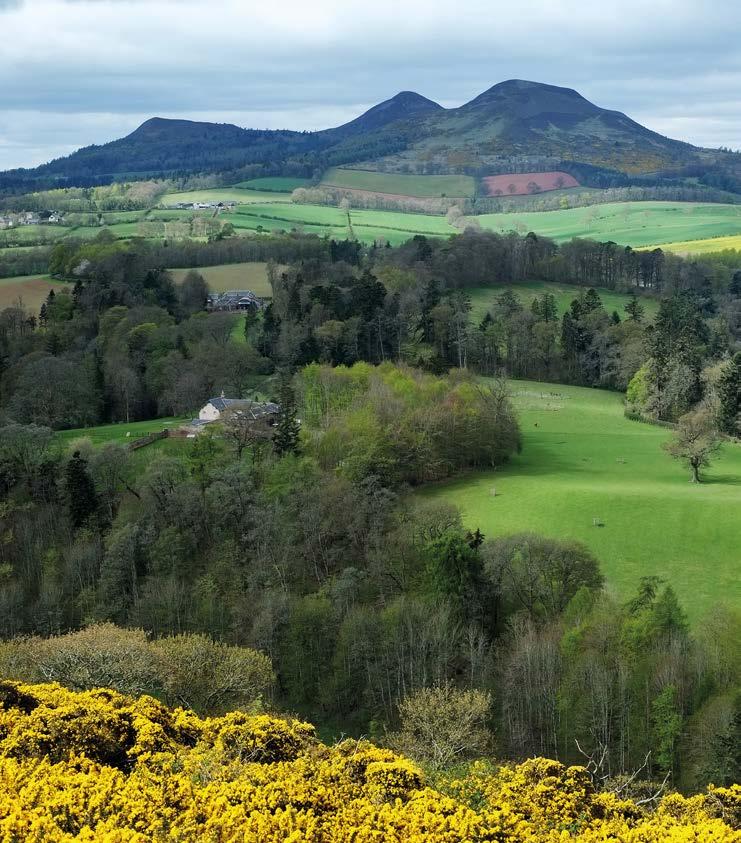
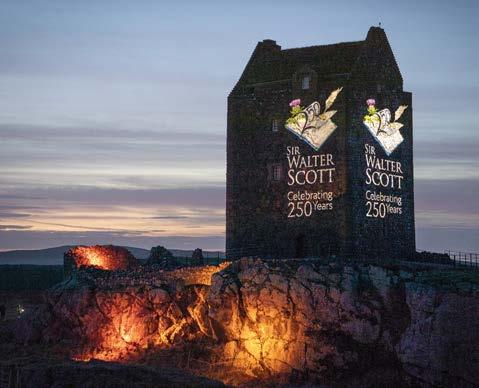
moonlight “buttress and buttress LEFT: Scott’s View alternately, seem framed of ebon and ivory”. near Melrose BELOW: A light show at Smailholm By the mid-1820s when Scott had Tower in the completed Abbotsford, his dramatic Borders launched home on the banks of the River Tweed near Melrose, visitors to the the Scott250 celebrations area were numerous. Scott himself was popular and hospitable. “He had a stream of guests staying,” says Giles Ingram, chief executive of Abbotsford. “In his journal he talks of his routine. He’d rise early and descend from his bedroom using a spiral staircase in one of the towers into his study. He’d emerge once he’d written his pages for the day and then be the social host.” Lumsden adds: “We know from his correspondence and his journal that when people turned up at Abbotsford and wanted to meet him, he nearly always made time for them. I think at times that was a bit of burden: he’d rather get on and write his novels. But he never turned them away and he was always very, very welcoming.” After Scott’s death in 1832, the visitors continued. “His family weren’t financially well off and visitors were charged to see the house,” explains Ingram. “For that reason, the rooms people visit today are so remarkably untouched. They are very much as Scott left them because that is what people wanted to see. By the 1850s, the numbers were so high that the family had to change the entrance into the house to accommodate the visitors,” he adds. In his lifetime, Scott was adamant the estate was open to anyone. And that tradition of free access continues with thousands enjoying the grounds through the pandemic. Scott’s warm welcome – and the fact he was one of the most famous SIR WALTER SCOTT living Scotsmen of his time – made 250 CELEBRATIONS him the obvious person to host a visit by the new king, George IV, to Events to mark the 250th Edinburgh in 1822. With plenty of anniversary of Scott’s birth colourful pageantry and the king are planned until August 2022, dressed in tartan, once again Scott with celebrations taking place was nourishing the flourishing both in person and online. interest in his country. Go to the Sir Walter Scott 250 Scott’s role in developing Scotland website to find out how you as a tourist destination might have can join in, no matter where been an unexpected consequence of you are in the world. the circumstances of his times, but it walterscott250.com must surely be considered one of the most valuable parts of his legacy. S
SUBSCRIBE AND SAVE UP TO 22%
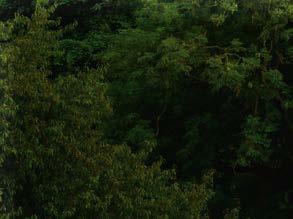


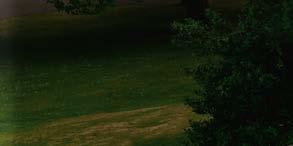

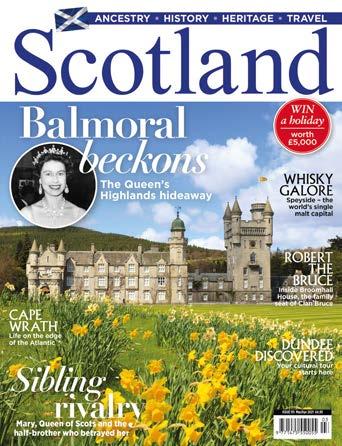
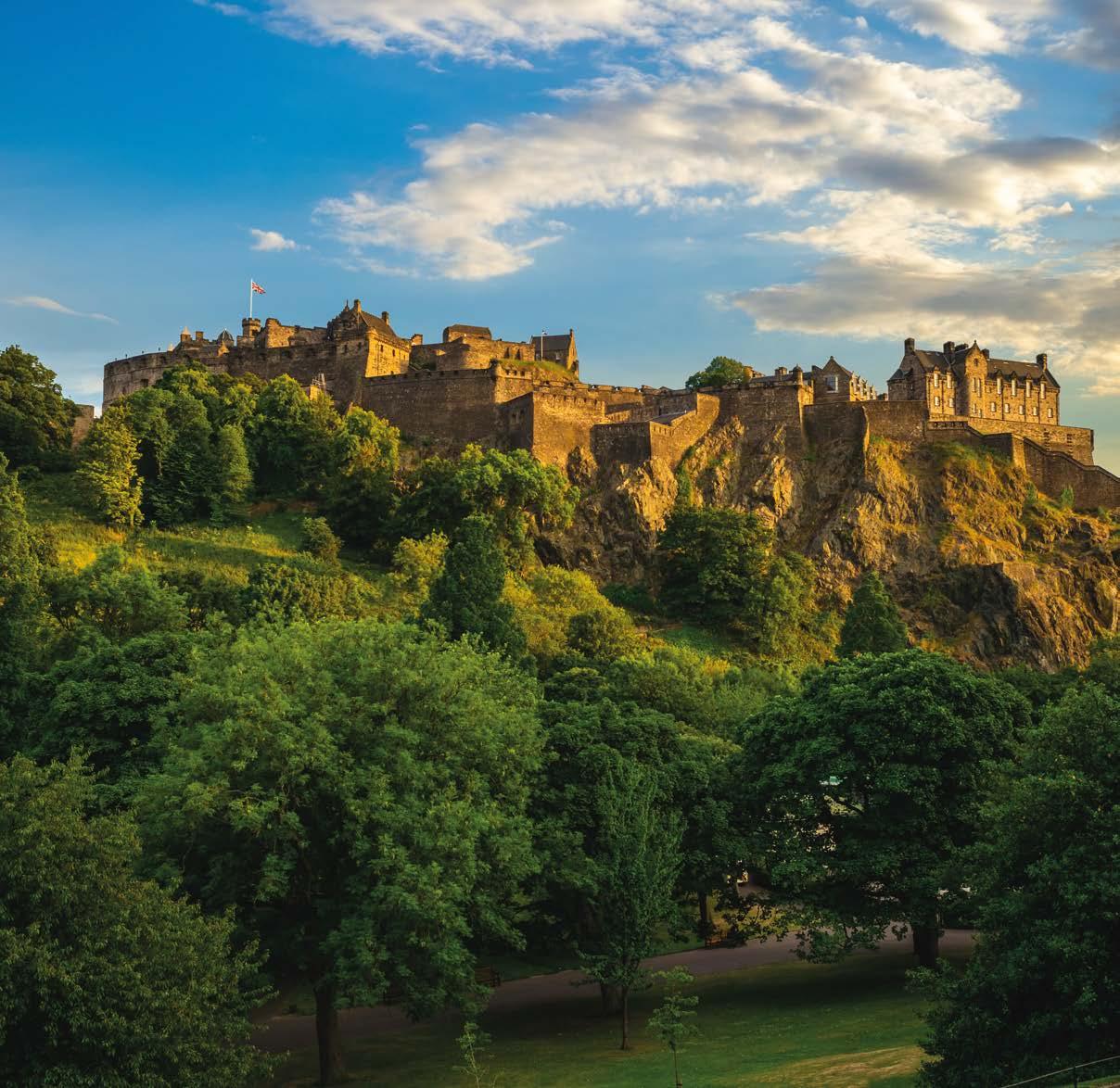


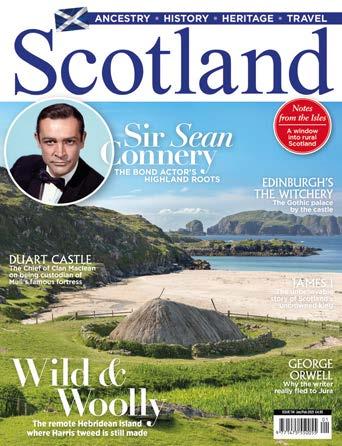

FREE delivery to your home includes
Become a subscriber today
Get an annual subscription to Scotland magazine for you or as a gift: UK £21.95 | Rest of World £33.95 | Europe €38.95 | USA $44.95 | Australia $66.95




